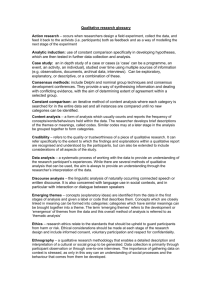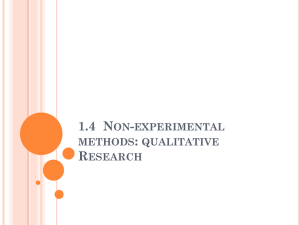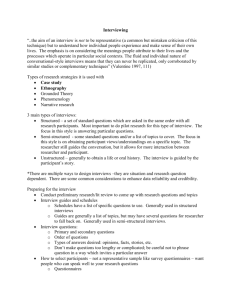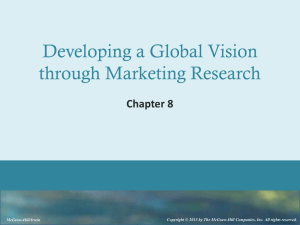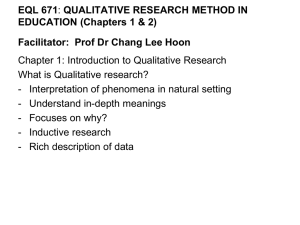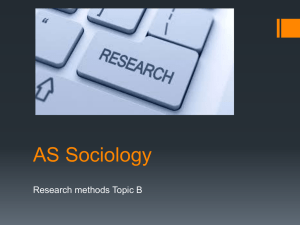Paper 3 Workbook Answers
advertisement
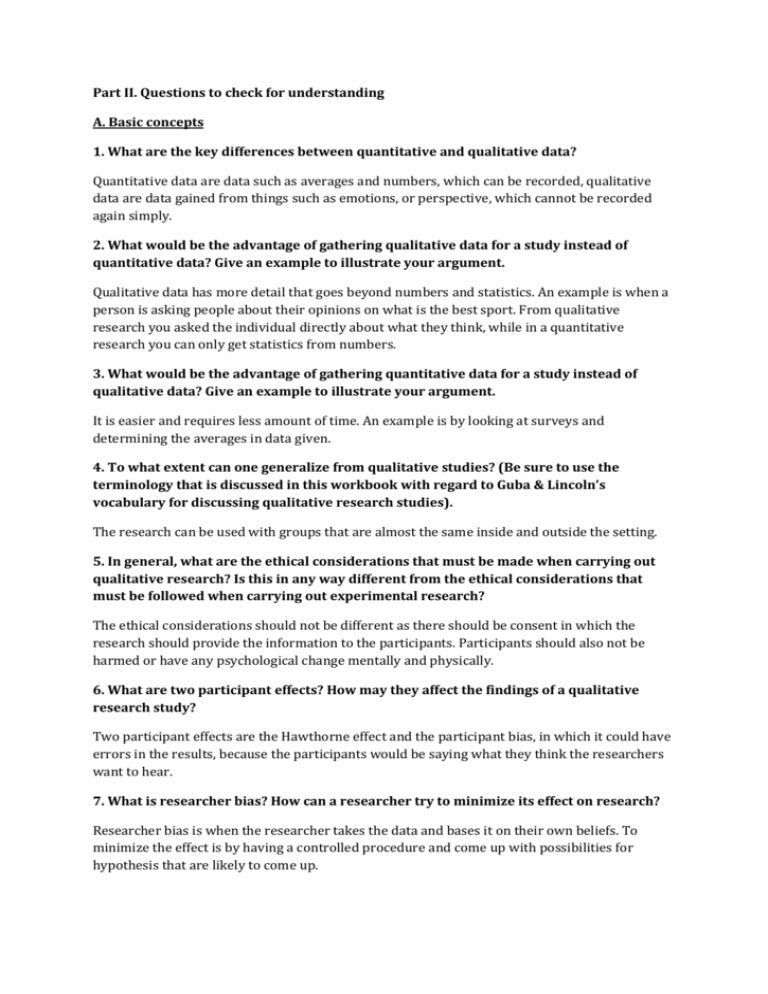
Part II. Questions to check for understanding A. Basic concepts 1. What are the key differences between quantitative and qualitative data? Quantitative data are data such as averages and numbers, which can be recorded, qualitative data are data gained from things such as emotions, or perspective, which cannot be recorded again simply. 2. What would be the advantage of gathering qualitative data for a study instead of quantitative data? Give an example to illustrate your argument. Qualitative data has more detail that goes beyond numbers and statistics. An example is when a person is asking people about their opinions on what is the best sport. From qualitative research you asked the individual directly about what they think, while in a quantitative research you can only get statistics from numbers. 3. What would be the advantage of gathering quantitative data for a study instead of qualitative data? Give an example to illustrate your argument. It is easier and requires less amount of time. An example is by looking at surveys and determining the averages in data given. 4. To what extent can one generalize from qualitative studies? (Be sure to use the terminology that is discussed in this workbook with regard to Guba & Lincoln’s vocabulary for discussing qualitative research studies). The research can be used with groups that are almost the same inside and outside the setting. 5. In general, what are the ethical considerations that must be made when carrying out qualitative research? Is this in any way different from the ethical considerations that must be followed when carrying out experimental research? The ethical considerations should not be different as there should be consent in which the research should provide the information to the participants. Participants should also not be harmed or have any psychological change mentally and physically. 6. What are two participant effects? How may they affect the findings of a qualitative research study? Two participant effects are the Hawthorne effect and the participant bias, in which it could have errors in the results, because the participants would be saying what they think the researchers want to hear. 7. What is researcher bias? How can a researcher try to minimize its effect on research? Researcher bias is when the researcher takes the data and bases it on their own beliefs. To minimize the effect is by having a controlled procedure and come up with possibilities for hypothesis that are likely to come up. 8. What does it mean if we say that a study lacks “credibility?” Why is this important in qualitative research? If a study lacks credibility it means that the study is not reliable, it is important because researchers want to publish data as accurately as possible. 9. Define triangulation, giving two examples of how it works. Triangulation is the process of confirming information and results concluded by the study, checking the procedure and sources like a triangle. 10. Why is triangulation important in qualitative research? How does it affect the credibility of the study? It is important because in qualitative research the result need to be confirmed and be as accurate as possible. By having the researched check it will affect the credibility by matching them with other known data. 11. Explain what is meant by reflexivity – and why it is an important part of qualitative research. Reflexivity is the process when the researchers are bias in collecting data in a study, it is important because it the bias beliefs of the researchers may provide wrong data. II. Sampling techniques 1. Explain what is meant by “purposive sampling.” Why is this often used in qualitative research studies? It is meant to be searching specific group for the study because of particular attributes like gender, making it very specific in studies. 2. In order to achieve a purposive sample, researchers often use self-selected samples. What are one strength and one limitation of this type of sampling? One of the strength is that it could be focused on the effects that are examined and the results would be in detail, while a limitation is that it could cause biasness in the resulting in false information. 3. Two other types of sampling used are snowball samples and quota samples. Explain why a psychologist may choose to use these samples, and explain one disadvantage of each. Snowball samples are used for getting more participants, while a limitation shows that it is more likely to get bias results, taking away the reliability. A quota sample has a limited amount of participants, while researchers could be bias on picking participants. III. Interviews 1. What is meant by a “semi-structured interview?” Why would a researcher use this method? What would be the strengths and limitations of this interviewing technique? A semi-structured interview is an interview-based research used in finding about socially sensitive issues through one on one interview and the strength is that it could provide a lot of data. The limitations of this technique are that it would take a lot of preparation time. 2. What is meant by a “focus group?” Why would a researcher use this method? What would be the strengths and limitations of this interviewing technique? A focus group is when the researcher uses data collection in a group setting, because it is fast and very efficient, but it could lack reliability. 3. What is meant by a “narrative interview?” Why would a researcher use this method? What would be the strengths and limitations of this interviewing technique? A narrative interview is to gain data by interviewing people making them identify the social and cultural factors of a certain cause. The strength is that is can give a lot of information but the limitations are that the data could be very complex to analyze which could also take up a long time. 4. What are three things that a researcher should do when setting up or planning to conduct an interview? They should consider ethical issues, create questions that would bring no biased results, and express gratitude after the interview is over. 5. What are three things that a researcher should remember when carrying out an interview? They should ask question that are not bias towards an answer, record exact answers, and be respectful to the participants. 6. What are some of the difficulties of carrying out a one-on-one interview? A group interview? One-on-one interviews also take a lot of time because the researcher needs to prepare multiple questions multiple times. However in the group interview though it has very limited question, conflicts and difference in opinion can occur. 7. What ethical considerations must be made when carrying out an interview? The interviewer should consider sensitive topic that he/she may think affects the person being interviewed. The interviewer should the data recorded accessible and editable by the person who is interviewed. 8. What is the difference between traditional and postmodern transcription methods? Traditional methods focus on using the recorded interview and later transcribe the interview word for word, while post modern methods involves the interviewer to do multi-tasking, asking questions and recording the answers even for the body language or non verbal communication the individual uses. 9. Explain how an inductive content analysis would be used to analyze and interpret an interview. Inductive content analysis is a qualitative method of analysis that researchers use to analyze things such as by studying things such as documents or recordings. As the name implies, inductive content analysis relies on inductive reasoning, in which themes emerge from the raw data through repeated examination and comparison. 10. Define back translation. Why would an interviewer use this technique? Back translation is the process of translating a document already translated into another language back to the original language it was written in. Interviewers use this technique to check the accuracy of the translation that is made. 11. How could an interviewer increase the credibility of his findings? The researcher should add insights based on the research and analysis without being biased with personal opinions. IV Observations 1. Define participant observation. What is one advantage of this method? One disadvantage? Participant observation is when the observer is also studied along with the group, while giving understandings of group. The advantage of this method is that it avoids researcher bias, while a disadvantage is it is difficult to record data on time. 2. Discuss how two different participant effects may overly influence an observation. The participants’ difference in opinion of the research and the researcher may affect the trustworthiness of the observation. There also could be participant bias because they’re behaving differently influencing the observation. 3. What is a naturalistic observation? Explain the strengths and limitations of carrying out a naturalistic observation rather than a controlled observation. Naturalistic observation is a type of observation used in research to observe participants in a natural environment. An advantage of this observation is that it is reliable as it is raw data and the reactions are the people’s reflexes, while a disadvantage is that it has ethical considerations about researching on someone without telling them. 4. What are the advantages of a non-participant observation? The advantages are that it is really fast and easy. 5. What is a covert observation? When would this technique most likely be used? What are some of the limitations of this technique? Covert observations are when the participant of the study is not informed about them being studied. The strength of this technique is that it would provide raw data, but the limitations of this technique are that it is not ethical. 6. Discuss three things that a researcher must do to prepare to carry out an observation. The researcher must create a question on what to be observed, prepare a hypothesis and reasoning, and prepare and plan a type of research observation. 7. What is meant by inter-coder or inter-rater reliability? It is the agreement among the raters relating to judgments for a behavior. 8. Explain the three techniques of recording data during an observation: event sampling, time sampling, and point sampling. Event sampling is recording observations in an unlimited amount of time but asking about all the specifics. Time sampling is observations, which are based on sets amounts of time, and point sampling is recording of observation aimed at individual points. 9. Explain how an inductive content analysis might be used to analyze and interpret an observation. How could the researcher increase the credibility of the findings? As the name implies, inductive content analysis relies on inductive reasoning, in which themes emerge from the raw data through repeated examination and comparison. Researchers could increase their credibility of their findings by repeating the observation and comparing the data. 10. What are the limitations of the technique of inductive content analysis? The Limitations of the inductive content analysis is that there is no reason in explaining the results. V Case Studies 1. A case study, in and of itself, is not a method. What is meant by this statement? A case study is not a method of study, but the researcher select methods of the data collect which will suit the case study like qualitative research. 2. Case studies use an idiographic approach. Explain what is meant by this term. An idiographic approach is relating the study to the individual. 3. What are two advantages of using a case study approach? Case studies give a lot of detail and have a greater depth, and experiments can be done to prove case studies. 4. What are three disadvantages of using a case study approach? The disadvantages are that the data collected from a case study cannot be implied to other individuals, the data is not very scientific, and it is focused on one person or a group, which makes it hard to draw conclusion into whether it will work on another group without experimenting again. 5. What ethical considerations must be made when carrying out a case study? In case studies the researcher must state the clear purpose of the study, while keeping information of the individual confidential, and cause no harm in while carrying out the study. 6. Discuss how you would set up and carry out a case study on our school. I would set up a case study on how a certain person does their homework after reaching home. I would be setting up a questionnaire while doing one on one interview and have naturalistic observations. I would think of a question like do people that are in clubs such as Debate or MUN have a higher GPA. Then I would ask the people in the clubs through questionnaires, and observe their behavior, which might lead to them having a higher GPA. 7. To what extent could you generalize the findings from the case study that you planned out for question 6? I would conclude answers based on the questionnaire, interview, and naturalistic observation would have similar results, and then perform the experiment again for credibility.

